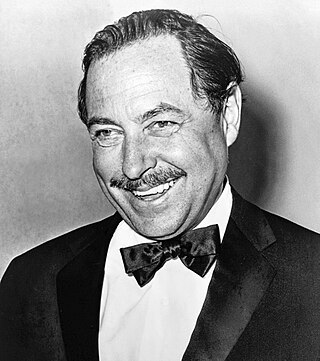
Thomas Lanier Williams III, known by his pen name Tennessee Williams, was an American playwright and screenwriter. Along with contemporaries Eugene O'Neill and Arthur Miller, he is considered among the three foremost playwrights of 20th-century American drama.

In Greek mythology, the Oceanids or Oceanides are the nymphs who were the three thousand daughters of the Titans Oceanus and Tethys.

Haywood County is a county located in the U.S. state of Tennessee, in the region known as West Tennessee. As of the 2020 census, the population was 17,864. Its county seat and largest city is Brownsville. It is one of only two remaining counties in Tennessee, along with Shelby County, with a majority African-American population.

Brentwood is a borough in Allegheny County, Pennsylvania, United States. The population was 10,082 at the 2020 census. It is a residential suburb of the Pittsburgh metropolitan area.

Brownsville is a city in and the county seat of Haywood County, Tennessee, United States. Its population as of the 2020 census was 9,788. The city is named after General Jacob Jennings Brown, an American officer of the War of 1812.

The governor of Tennessee is the head of government of the U.S. state of Tennessee and the commander-in-chief of the state's military forces. The governor is the only official in the Tennessee state government who is directly elected by the voters of the entire state.

Acer pseudoplatanus, known as the sycamore in the British Isles and as the sycamore maple in the United States, is a species of maple native to Central Europe and Western Asia. It is a large deciduous, broad-leaved tree, tolerant of wind and coastal exposure.

Nicholas Charles Sparks is an American romance novelist, screenwriter, and film producer. He has published twenty-three novels, all New York Times bestsellers, and two works of non-fiction, with over 115 million copies sold worldwide in more than 50 languages. Among his works are The Notebook, A Walk to Remember, and Message in a Bottle which, along with eight other books, have been adapted as feature films.

Newton Cannon was an American politician who served as the eighth Governor of Tennessee from 1835 to 1839. He also served several terms in the United States House of Representatives, from 1814 to 1817, and from 1819 to 1823. Cannon was a long-time foe of Andrew Jackson, and spent much of his political career opposing Jacksonite policies. Cannon was succeeded as Governor of Tennessee by James K. Polk in 1839, who later became President of the United States.

John Adam Estes, known as Sleepy John Estes, was an American blues guitarist, songwriter and vocalist. His music influenced such artists as the Beatles, Bob Dylan and Led Zeppelin.

George Washington Gordon was a general in the Confederate States Army during the American Civil War. After the war, he practiced law in Pulaski, Tennessee, where the Ku Klux Klan was formed. He became one of the Klan's first members. In 1867, Gordon became the Klan's first Grand Dragon for the Realm of Tennessee, and wrote its "Precept," a book describing its organization, purpose, and principles. He was also a member of the United States House of Representatives for the 10th congressional district of Tennessee.

The Watauga Association was a semi-autonomous government created in 1772 by frontier settlers living along the Watauga River in what is now Elizabethton, Tennessee. Although it lasted only a few years, the Watauga Association provided a basis for what later developed into the state of Tennessee and likely influenced other western frontier governments in the trans-Appalachian region. North Carolina annexed the Watauga settlement area, by then known as the Washington District, in November 1776. Within a year, the area was placed under a county government, becoming Washington County, North Carolina, in November 1777. This area covers the present day Washington County, Carter County, and other areas now located in the northeast part of the state of Tennessee.

The Sycamore Shoals of the Watauga River, usually shortened to Sycamore Shoals, is a rocky stretch of river rapids along the Watauga River in Elizabethton, Tennessee. Archeological excavations have found Native Americans lived near the shoals since prehistoric times, and Cherokees gathered there. As Europeans began settling the Trans-Appalachian frontier, the shoals proved strategic militarily, as well as shaped the economies of Tennessee and Kentucky. Today, the shoals are protected as a National Historic Landmark and are maintained as part of Sycamore Shoals State Historic Park.

Sycamore Shoals State Historic Area is a state park located in Elizabethton, in the U.S. state of Tennessee. The park consists of 70 acres (28.3 ha) situated along the Sycamore Shoals of the Watauga River, a National Historic Landmark where a series of events critical to the establishment of the states of Tennessee and Kentucky, and the settlement of the Trans-Appalachian frontier in general, took place. Along with the historic shoals, the park includes a visitor center and museum, the reconstructed Fort Watauga, the Carter House and Sabine Hill . For over a thousand years before the arrival of European explorers, Sycamore Shoals and adjacent lands had been inhabited by Native Americans. The first permanent European settlers arrived in 1770, and established the Watauga Association—one of the first written constitutional governments west of the Appalachian Mountains—in 1772. Richard Henderson and Daniel Boone negotiated the Treaty of Sycamore Shoals in 1775, which saw the sale of millions of acres of Cherokee lands in Kentucky and Tennessee and led to the building of the Wilderness Road. During the American Revolution, Sycamore Shoals was both the site of Fort Watauga, where part of a Cherokee invasion was thwarted in 1776, and the mustering ground for the Overmountain Men in 1780.

Jerry Richard Blevins, nicknamed Gordo, is an American former professional baseball pitcher. Blevins was drafted by the Chicago Cubs in the 17th round of the 2004 Major League Baseball draft, and made his major league debut in 2007. He played in Major League Baseball (MLB) for the Oakland Athletics, Washington Nationals, New York Mets and Atlanta Braves. He currently serves as a studio analyst for the New York Mets' pregame and postgame shows on SNY, where he sometimes does color commentary for the network.

The 1997 Tennessee Volunteers football team represented the University of Tennessee during the 1997 NCAA Division I-A football season. Quarterback Peyton Manning had already completed his degree in three years, and had been projected to be the top overall pick in the 1997 NFL Draft, but returned to Tennessee for his senior year. The Volunteers opened the season with victories against Texas Tech and UCLA, but for the third time in his career, Manning fell to Florida, 33–20. The Vols won the rest of their regular season games, finishing 10–1, and advanced to the SEC Championship Game against Auburn. Down 20–7, Manning led the Vols to a 30–29 victory. Throwing for four touchdowns, he was named the game's MVP, but injured himself in the process. The #3 Vols were matched up with #2 Nebraska in the Orange Bowl. Had Tennessee won and top-ranked Michigan lost to Washington State in the Rose Bowl, the Vols would have been expected to win the national championship. However, the Vols' defense could not stop Nebraska's rushing attack, giving up more than 400 yards on the ground in a 42–17 loss. As a senior, Manning won numerous awards. He was a consensus first-team All-American and won the Maxwell Award, the Davey O'Brien Award, the Johnny Unitas Award, and the Best College Football Player ESPY Award, among others. However, he did not win the Heisman Trophy, finishing runner-up to Charles Woodson, a CB from Michigan, and the only defensive player ever to win the Heisman Trophy.
Esenbeckia runyonii is a species of flowering tree in the citrus family, Rutaceae, that is native to northeastern Mexico, with a small, disjunct population in the Lower Rio Grande Valley of Texas in the United States. Common names include Limoncillo and Runyon's Esenbeckia. The specific epithet honors Robert Runyon, a botanist and photographer from Brownsville, Texas, who collected the type specimen from a stand of four trees discovered by Harvey Stiles on the banks of Resaca del Rancho Viejo, Texas, in 1929. Conrad Vernon Morton of the Smithsonian Institution received the plant material and formally described the species in 1930. Some consider it a synonym of E. berlandieriBaill. ex Hemsl..

Robert Michael "Mike" Walker is the former United States Under Secretary of the Army (1997-1998).
Thomas Isham Webb Jr., (1880–1975) was a Tennessee attorney who excelled at golf and won the 1913 Tennessee state amateur. He was one of Tennessee's earliest golfers at the cusp of the sport's popularity in the United States near the beginning of the twentieth century. While a student at Vanderbilt University in 1896, Webb constructed a rudimentary nine-hole golf course next to University campus and the group attracted like-minded golf enthusiasts. Prominent citizens became interested and eventually formed a golf club which still exists over a century later. In 1901, Webb was a charter member of the Nashville Golf and Country Club where Grantland Rice, Webb's Vanderbilt classmate, first became interested in golf. The club was later renamed "Belle Meade Country Club" and Webb was the club golf champion in 1913 and 1917. At the time of his death at age 95, Webb was celebrated as club's oldest living member. He endowed an annual trophy for the Belle Meade Junior Golf championship; a room named for him was dedicated by in 1976 by sportswriter Fred Russell.

The 1902 Tennessee gubernatorial election was held on November 4, 1902. Democratic nominee James B. Frazier defeated Republican nominee Henry Tyler Campbell with 61.77% of the vote.




















